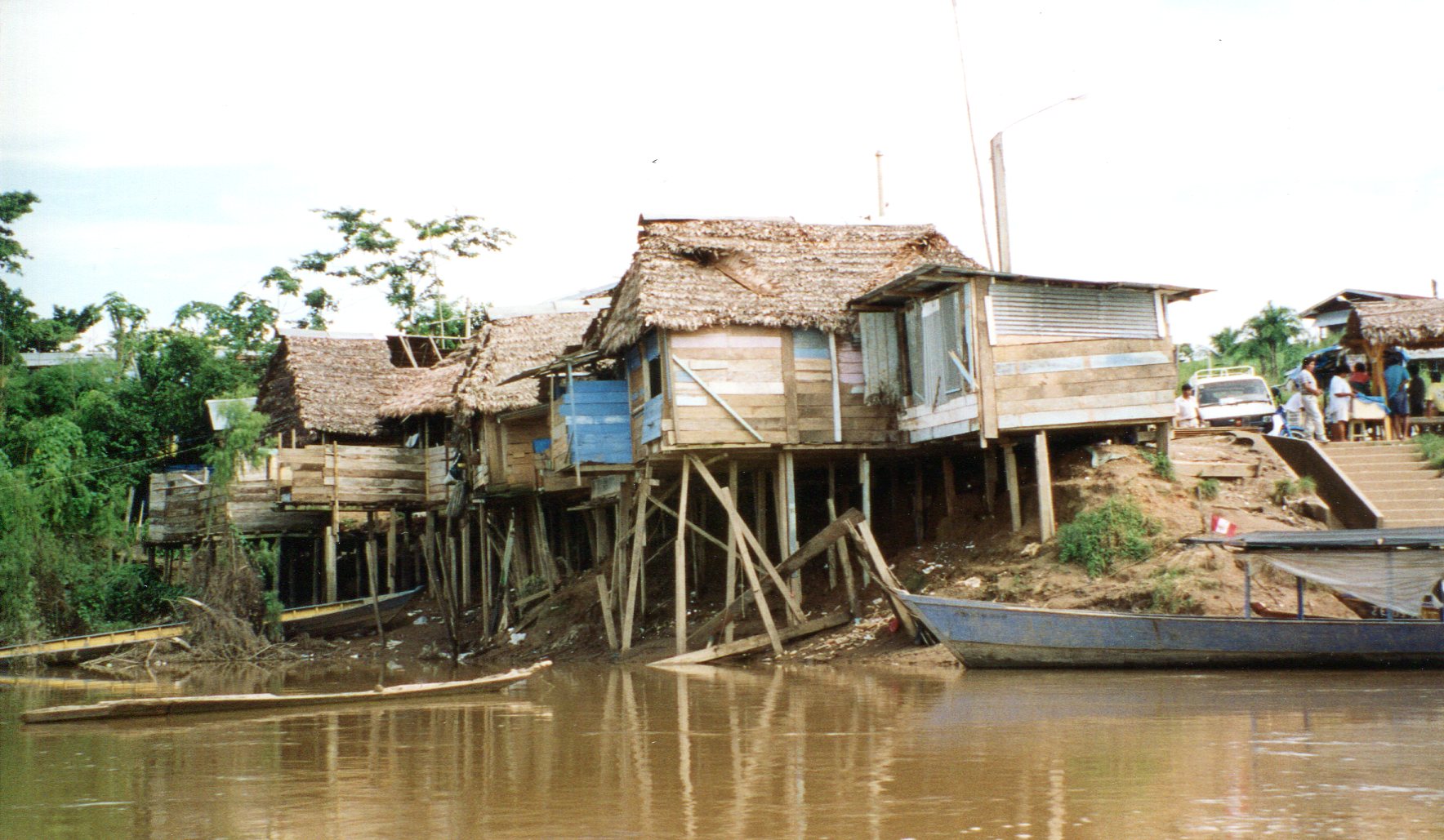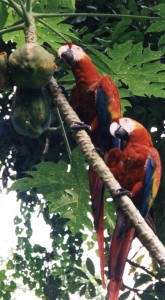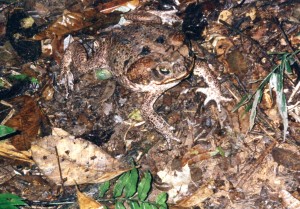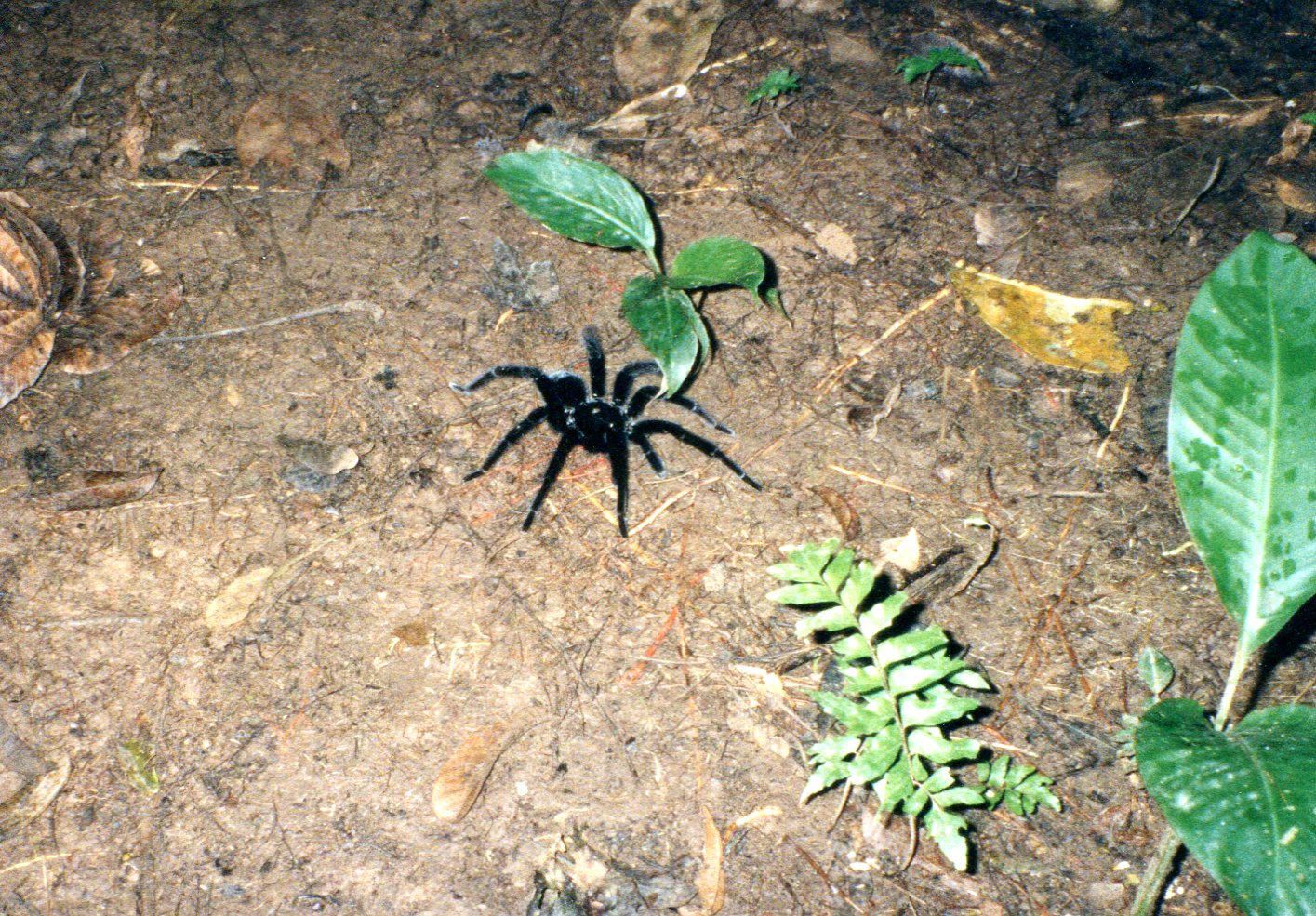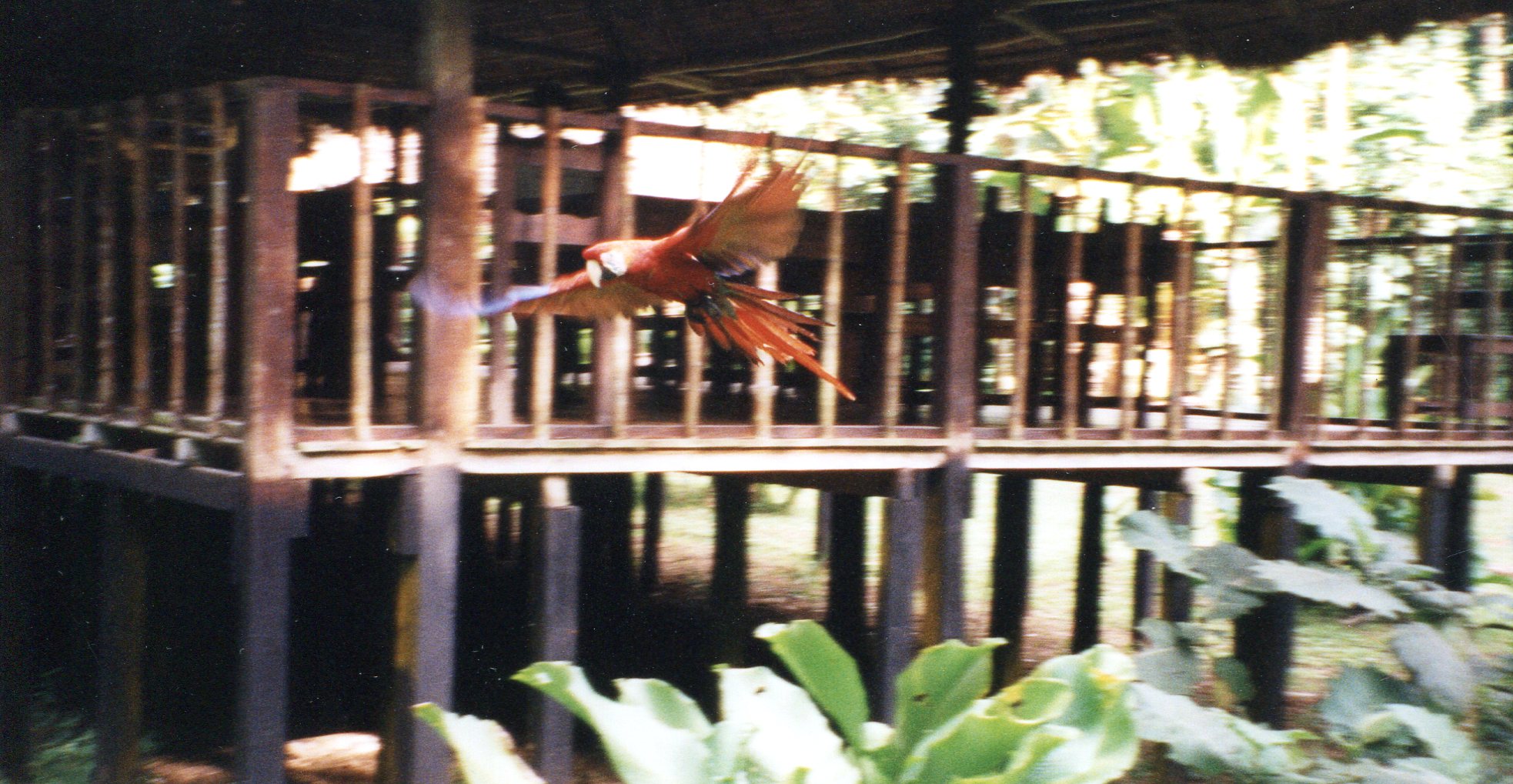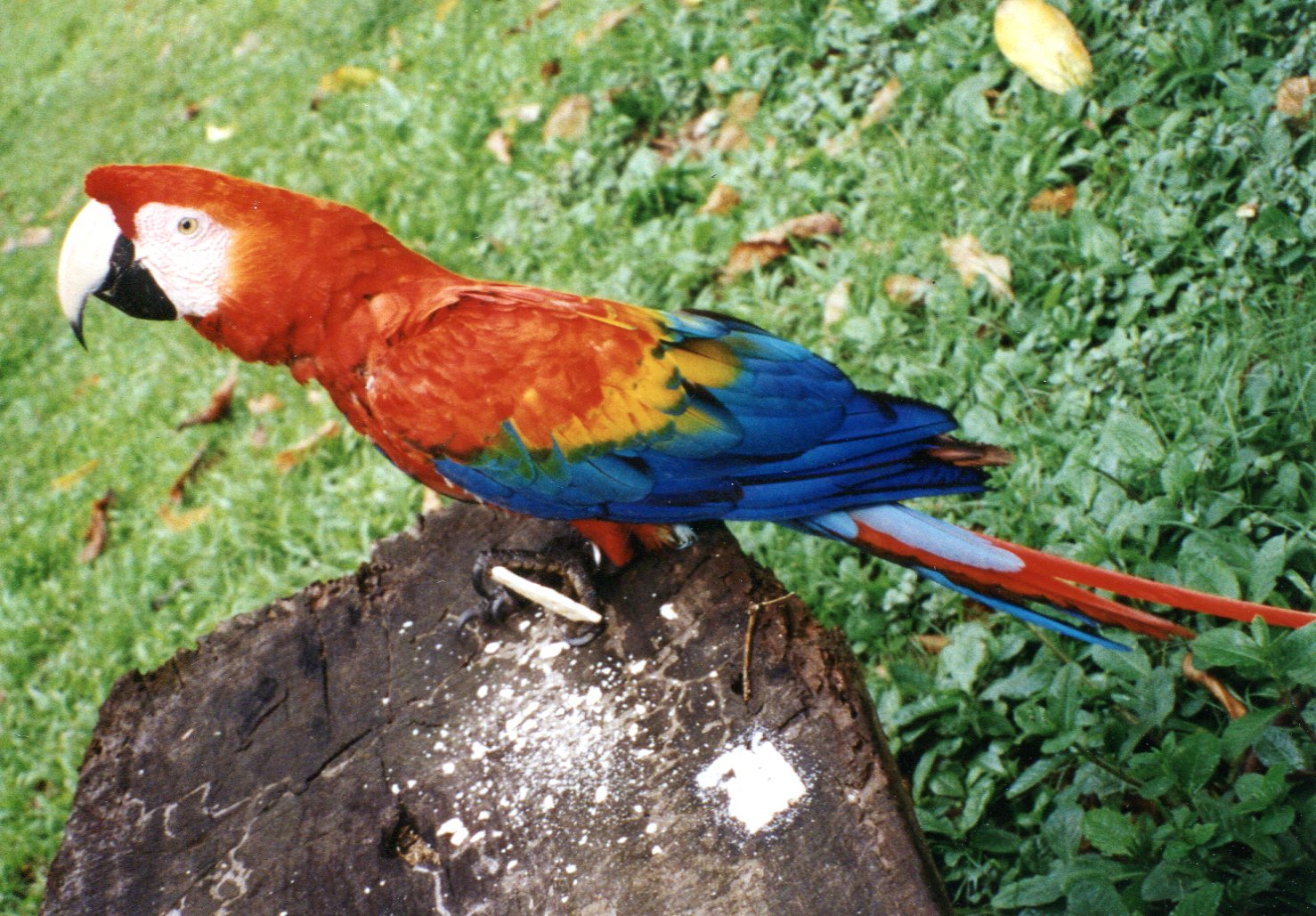(Originally published in the March 1999 issue of Animal People News)
Chugging up the Rio Tambopata, one of the major Amazon tributaries, in a motorized canoe, we were struck during a January 1999 visit to the Tambopata-Candama Reserved Area in southeastern Peru by the contrast between the Amazonian rainforest as it is and the image most people have of it – an image crafted over the past few decades chiefly by conservation groups.
Funding rainforest research, documentary film-making, lobbying, and even the start-up of ecotourism, most of these organizations have also rather blindly stumbled down the tangled trail blazed since 1961 by the World Wildlife Fund.
WWF, as ANIMAL PEOPLE has often pointed out, is not just the world’s wealthiest and most influential wildlife advocacy group: it also happens to be the world s best-disguised lobby for sport hunting and other consumptive wildlife use.
WWF founder Peter Scott was the duck-shooter who introduced the North American ruddy duck to England; WWF and allies now clamor for an expanded ruddy duck season and no bag limit, on the bio-xenophobic claim that ruddy ducks are miscegenating English white-headed ducks into illegitimate hybrids.
Other WWF founding members included whaling baron Aristotle Onassis, then-National Rifle Association president C.R. Pink Gutermuth, and Princes Philip of Britain and Bernhardt of The Netherlands. The princes are each notorious for shooting now rare tigers, elephants, and other wild species by the hundred in their youth, and for more recently shooting cage-reared birds and rabbits, sometimes thousands in a day.
Apparently inspired by the success of the U.S.-based National Wildlife Federation, an umbrella for 48 state hunting clubs founded in 1936, the self-perpetuating WWF inner circle has from start-up pushed the theory that habitat should be preserved with the proceeds from killing animals while raising much of their operating capital from people who are under the illusion that WWF either opposes hunting or only grudgingly accepts what it officially terms responsibly conducted hunting, as an appropriate wildlife management tool, particularly for abundant game that is maintained on a sustainable basis.
Of course, the WWF policy statement adds, World Wildlife Fund opposes hunting which might adversely affect the survival of threatened or endangered species.
That puts a politically correct spin on the mayhem.
For nearly 40 years now, WWF has been among the major funders of field biology and zoological conservation. Newer wildlife conservation organizations, academia, and the zoo community include an army of experts whose careers and professional perspective have been shaped by WWF funding policy just as surely yet invisibly as military/industrial complex salespeople shape Pentagon strategic planning.
By now the WWF sustainable use euphemism for hunting promotion is a mantra, repeated at all levels of rainforest research and policy-making and most of the people espousing it have no idea where it originated. This manta is supported by a whole canon of alleged fundamental precepts of rainforest ecology, which are taken on faith by the very scientists who should be most vigorously asking questions.
As we observed both from the canoe during 14 hours on the Rio Tambopata and during approximately 80 person-hours of hiking and field study, many field biologists and nature interpreters are reporting on the emperor’s new clothes: seeing what they have been taught to see; imagining the relationships of humans and wildlife they have been told exist; and missing howling evidence that the emperor is stark naked, mosquito-bitten, and mad as a hatter.
The color of the Tambopata was the first clue: a muddy brown which we understand only gets darker and thicker as it flows more than 2,500 miles to the Atlantic. From Puerto Maldonado to the Posadas Amazonas Lodge two hours upstream, owned by the Ese eja tribe but operated by Rainforest Expeditions Inc., and then to the Tambopata Research Center five hours beyond, we were continuously beside collapsing clay banks. We were told the banks had always eroded so, because of the heavy Amazon rains.
Yet, low as the land was, the river wasn’t even as wide as the Hudson at West Point. If such erosion had truly continued for many decades, uninterrupted, let alone for centuries, we d have been in a vast swamp, like the Everglades.
Clearly some form of vegetation had once held the 20-to-100-foot-high banks well enough to allow the river to channel through them, and to keep it channeled, albeit snaking, until relatively recent times.
The trees were the second clue. Our corner of Whidbey Island, Washington, has been clear-cut twice since 1890, yet there may be more old growth in the steeper ravines within half a mile of here than we saw in our entire Amazonian expedition – even though the Tambopata Nature Reserve, where we spent much of four days, has never been commercially logged. There was some old growth, however: isolated big trees, taller and thicker than most of the rest, inevitably with burn scars. Lightning strikes? Rarely: some had been zapped, with tell-tale high fractures, but the damage rarely continued down the full length of the trunk, and most of the deep scarring was low, on roots resembling the buttresses of medieval cathedrals.
Photographs of the Tambopata lodge when first built in 1990 confirmed that all the surrounding trees, including the very tallest, had grown considerably since then.
Fire and farming
The Tambopata rainforest as we saw it appears to be not exactly wilderness, despite the sparse human population within the Tambopata-Candama Reserved Area where the Tambopata Research Center stands. Contrary to official belief, it appears also to be at least partially the product of centuries of fire-based cultivation. Our estimate, judging by tree sizes and burn scars, was that the region right around TRC, considered pristine by the resident conservation biologists, was probably last burned from 40 to 60 years ago.
Downstream, similar damage is far more recent and documented, including in a video shown to Posadas Amazonas visitors.
Our hypothesis is that humans may have begun burning off portions of Tambopata as long as 2,500 years ago, as indicated by excavations in the Brazilian Amazon conducted during the 1970s and 1980s by American Museum of Natural History archaeologist and anthropologist Anna C. Roosevelt. Until Pizarro captured most of the Inca empire in 1532, the rainforest natives might have practiced mainly the “circular field” technique documented among the Kayapo people of the central Amazon region by Darrell A. Posey of the Goeldi Museum in Belem, Brazil.
As New York Times science writer William K. Stevens summarized in 1990, “Circular fields are cleared from the center outward. When key trees are felled, they bring down many smaller ones. The crowns fall toward the periphery. Yams, potatoes, manioc and other tubers are planted between the felled trees. When the trees are burned, the tuber roots keep the [ash-enriched] soil from washing away. Most of the ash falls at the edge of the circle, to feed the hungriest crops. Crops are planted in rings, according to their needs for food and light. After a few years, planting is halted. Corn and rice disappear from the field, but potatoes and yams continue to yield for years afterward. The forest begins to encroach on the field, bringing with it fruit trees, palms, and medicinal herbs, and wild berries, which attract wildlife to be hunted. The changing crops offer continuing sources of food and other useful plants without depleting the soil. Eventually the forest is restored.”
Before Pizarro, according to Roosevelt, Amazonian agrarian peoples maintained cities of up to 4,000 residents, built on earthen mounds linked by causeways to keep their homes safe from flooding. They traded food for Andean metal goods.
But whatever existed in pre-Columbian times, including the wildlife ecology of the rainforest itself, was almost certainly razed and dispersed beyond recognition after Pizarro. After Pizarro butchered the Inca dynasty, Andean refugees fled into the jungle perhaps by the tens of thousands, abandoning their laboriously constructed terraces, so well-built that they still conserve water, topsoil, and biodiversity in the cloud forests above.
Over the next 30 years, scorched-earth tactics proved to be the Andeans’ only successful defense. Only where they burned their rope-and-plank suspension bridges, homes, and graineries, erasing their trails, did many of them survive. Even those tactics failed, however, when in 1562 the Spanish found and massacred the populace of Villacabamba, the last Inca stronghold.
Of the estimated 350,000 residents of Cuzco, the Inca capital, barely 50,000 remained half a century after Pizarro came. Pizarro’s tiny army of just 64 horsemen with firearms killed many; the diseases they brought killed many times more. Andeans who reached the jungle then transmitted the deadly germs to the Amazonians. Roosevelt estimates that 85% of the Amazonian population died within a year of contact with the Spanish ailments.
In little more than one generation, the military onslaught, illness, and the circumstances of desperate flight appear to have erased all memory among the fugitive remnant population of agricultural techniques more sophisticated than slash, burn, plant, exhaust, and abandon – the methods practiced throughout the Amazon basin during the past 450 years, wherever people have even briefly settled.
The once tall, well-educated, long-lived, almost vegetarian Andeans became the diminutive, illiterate, short-lived hunter/gatherer People of the Forest, retaining only linguistic roots shared with the two major Andean native languages, DNA traces, and some legends as clues to their origin.
Animal behavior
Officially, the Tambopata reserve was never regularly inhabited by humans. That may be true, but between the demise of the Andean and Amazonian civilizations and modern times, no part of the rainforest ever was. Notoriously depleting topsoil, slash-and-burn impels frequent moves. Artifacts are few because people have been few and poor, manufactured little or nothing from lasting materials, and left remains which were easily scavenged, bones and all, by harpy eagles, cara cara vultures, bush dogs, maned wolves, foxes, wild pigs, and army ants. Acid soil soon dissolved whatever wasn’t eaten.
Yet there are traces of the transient human presence beyond the evidence of fires and erosion. There is the animal behavior. In India, humans are abundant even within tiger sanctuaries, but except for Moghul and British rulers, have rarely hunted wildlife since the advent of Hinduism, Buddhism, and Jainism more than 2,500 years ago. Animals of every kind are correspondingly as casual about a human presence as city dwellers are toward one another on street corners: they maintain discreet distance, and are wary, yet not shy. They are easily seen, even approached.
In Tambopata, by contrast, among the vertebrate wildlife, only several scarlet macaws who had been hand-reared from within days of hatching didn’t make themselves scarce at the first hint of a human sound or shadow. There has been no hunting, trapping, or parrot-catching in the vicinity for 15 years or more, but the cumulative effect of much hunting over the centuries has been to remove bold animals from the population, leaving only the shyest to pass along either their genes or their learned behavior.
Up and down the Tambopata, and at each stop, conservation biologists explained the wariness of the wildlife as a generalized response to the stress of survival in the rainforest, where food for animals other than birds, bats, and insects is scarce and both predation and habitat competition are correspondingly keen.
They also explained the scarcity of mammals as a consequence of food scarcity, and attributed the great biodiversity of the rainforest to food scarcity as well: supposedly, all creatures there have evolved to specialize in eating a particular thing that others pass over. Supposedly the few mammals are all specialists, kept few and often endangered because their habitat requirements are immense.
Biodiversity
The biologists were right that the Amazon rainforest harbors great biodiversity. According to a global species census published in January 1998 by Conservation International, just 17 nations collectively contain more than two thirds of the known species in the world. Among them are Brazil, Colombia, Peru, Ecuador, and Venezuela. Brazil is first in plants and mammals, second in amphibians. Columbia is first in amphibians and birds. Peru is second in birds.
On the other hand, the data is easily overstated. As many of the Amazon nations’ known vertebrates inhabit their mountain ranges and coastal sectors as well as actually dwell in the rainforest. Further, heavily populated and developed Britain has as much biodiversity per square mile as the Amazon rainforest, and about 3,000 species, 10% of the British total, have been observed and documented since 1970 in botanist Jennifer Owen’s garden in suburban London, making it the most biologically diverse single site on record.
The biologists’ argument for biodiversity as product of food scarcity accordingly contradicts both common sense and observable natural history. Comparable biodiversity, including among mammals, occurs in habitats of abundant food. Highly specialized mammals, like highly specialized animals of any clade, are scarce everywhere. Endangered species lists, around the world, are virtual catalogs of creatures with narrow niches. The most successful species in habitats with scarce food tend to be generalists, who eat anything. Thus raccoons, bears, and their close relatives are globally ubiquitous; rats thrive almost anywhere; and coyotes and jackals have proved ineradicable, even in desert.
Raccoons, spectacled bears, and rats are present in Peru. But the Peruvian generalist species mostly prefer the cloud forest. Food plants are much more plentiful on the Andean slopes, as are mammalian prey. Humans have tamed and cultivated many of the food plants, especially potatoes, beans, corn, and quinoa; sustained cultivation, unlike slash-and-burn, contributes to the abundance.
This is not to say that even the Peruvian wild species who have learned to co-exist with humans are especially common or evident. Peru seems to offer no locales comparable to Yellowstone National Park, the major reserves of India, or the Serengetti Plain, where many large mammals are seen almost at will. Because of the relatively heavy human presence and use of arable land, wild mammals are no more easily seen in the cloud forest than in the rainforest. Yet there do seem to be as many mammals, of as many species.
Abundance lost
An alternate explanation for Peruvian rainforest biodiversity might be not adaptation to food scarcity, but rather that we are looking at remnants of abundance lost. It seems likely that most of the animals seen today in the Peruvian rainforest were once much more common, including both the specialists and the generalists. Edge habitat and second growth tend to support both the greatest biodiversity and the largest numbers of individual animals. When the cyclical renewal of edge habitat via circular field cultivation ended, human populations abruptly diminished. Then slash-and-burn began, and the food supply for most species necessarily declined.
Where there were no humans, the year-round tree canopy might have shaded out most undergrowth. Where humans remained, runaway slash-and-burn fires followed a peculiar pattern recently discovered by Christopher Uhl and Mark D. Schulze of Pennsylvania State University and Mark A. Cochrane of the Woods Hole Research Center in Massachusetts: smouldering their way through the understory, killing shrubs and young trees but leaving about 90% of the biomass, mostly tall trunks and canopy. If rainfall is normal, the big trees withstand the damage but the understory may never recover. In dry years, like those after recent El Nino weather phenomena, the forest becomes even more tindery in the wake of fires, leading to further burns which take up to 40% of the biomass.
Cochrane and Schulze have speculated that recent burning trends could eventually convert much of the Amazon region into savannah.
Meanwhile, we suspect that almost every Amazonian animal species declined during the past five centuries. If the many Amazonian species now listed as endangered or threatened were always both as scarce and as far separated as most seem to be today, the most specialized might have long since run afoul of the same difficulty in finding mates and keeping genetic diversity as afflicts them today. Even a year or two of adverse weather might have pushed them to extinction. Instead, we surmise, they were gradually reduced from relative abundance to scarcity by steady attrition of their food supply.
Amazon slash-and-burn peasant farmers, both indigenous and non-indigenous, have to abandon their clearings and relocate in only two to five years, researchers have discovered, and their occasional runaway fires tend to raze far more forest than the farmers raze on purpose.
The farmers have been few until recent years, and their clearings relatively small, tending to grow over within five to six years after abandonment. But the depleted topsoil left by slash-and-burn does not grow understory at the former density. Instead, the canopies of trees surviving at the edges of clearings tend to expand over the open space, extending the shade cover.
After 450 years of burning and moving, even a mere handful of humans may have transformed much of the rainforest into a less hospitable place for ground-dwelling wildlife.
Human hunting pressure, especially as the Amazonian population rapidly grew in recent years, has hurt further, tending to keep any animal big enough to make a family meal from becoming numerous, even if the species could cope with the habitat transformation.
The biologists acknowledged that human predation had significantly depleted parrots, monkeys, giant otters, and other animals captured or hunted for either cash or meat. In almost in the same breath, however, the biologists at once denounced capturing wildlife for live resale and vigorously defended meat-hunting by indigenous people, even of some of the rarest mammals, with a two-part claim practically copied from WWF dogma.
First, they argued, the indigenous hunter/gatherers have protected and preserved rainforest biodiversity for centuries, and will continue to do so if they are allowed to go on practicing their traditional way of life. This was said while acknowledging that few indigenous people of the Amazon region are not by now thoroughly intermingled with more recent immigrants, and that most of the people still classified as indigenous have adopted modern ways and weapons to whatever extent they are able.
Second, the biologists asserted, the hunter/gatherers have no choice but to hunt, as they have no other source of protein (though they export protein-rich Brazil nuts as a cash crop) and as the thin rainforest topsoil will not sustain farming.
The biologists explained the thin topsoil as consequence of continual erosion caused by the daily rainfall. Discounting any possible human influence, they explained the paucity of plant food for mammals, humans included, as exclusively a consequence of the thick forest canopy, though it didn’t look any more dense than the summer canopy in a healthy New England woodlot.
Year-round shade, the biologists claimed, caused the absence of grass and understory in much of the rainforest. Without grass and understory, there is little fodder for either grazing or browsing ungulates, such as deer, and few of the flowering plants and berry bushes which in North America support abundant small mammals such as mice, rabbits, and their many predators.
No soil conservation
The biologists had little explanation when asked why the centuries of falling leaves, fruit, and branches have not created deep topsoil. They reminded us of the rain. We pointed out to them the depth of topsoil found in much of India and Southeast Asia, whose monsoons bring at least as much rain and tend to bring it in torrents.
Asian rainforest canopy is at least as thick, yet the Asian rainforest also has understory supporting elephants, bluebulls, sambar deer, and other mammals of all sizes in profusion, at least where not hunted or poached.
The real difference between the rainforests and topsoil of Asia and the Amazon, we submitted, is in their respective agricultural history.
In Asia, for thousands of years, farmers have practiced soil and water conservation. As we witnessed in November and December 1997, stone terraces, dykes, and drainage fields built centuries if not millenia ago still stand in parts of India that were returned to wildlife as far back as the mid-19th century, and are still doing their job, facilitating the lush plant growth that stimulates animal diversity.
In the Amazon, by contrast, similar methods developed by the Andeans in the cloud forest have rarely if ever been practiced below. Neither has the more primitive but still effective circular field method endured except among the Kayapo and a handful of other scattered tribes. Whatever dense rainforest understory once existed would appear to have been burned away countless times, repeatedly killing most of the plants whose roots could have held the topsoil. Even after the threat from the Spanish conquistadores faded, slash-and-burn ravaged the jungle, partly because the indigenous farmers no longer knew how to do otherwise and neither did the mestizo immigrants who arrived and intermarried with them, partly because the people were so few that they could always move on.
The human population of Peru apparently surpassed that of pre-Columbian times only within the past 30 to 50 years, whereas the human population of India, over the same interval, approximately tripled. Moving on hasn’t been an option for most Indian farmers since the epoch of Mahavira and the Buddha. For them, the essence of farming has been getting more production out of ever less land; and they have been remarkably successful, not only almost eradicating famine within the past two generations but also turning India into a net exporter of food, with much room left yet to continue improving productivity.
Along the Tambopata, the biologists insisted that even with advanced soil and water conservation methods, the Amazonian red clay could never be made to grow food for either humans or wildlife in abundance. It was clear they had never seen the red clay soil of Georgia, Alabama, and Tennessee.
Indeed, though conservation biologists specializing in wildlife were ubiquitous, it seemed likely that no agricultural conservation experts had ever informed and advised any aspect of Amazonian enterprise. Plantation growers in the region practice slash-and-burn much as do the indigenous people, but at a much accelerated pace, since they command chainsaws and bulldozers. Biologists devoted to saving the rainforest understandably perceive agriculture as the enemy, since all they know or see of it is the most destructive kind. No one has told them otherwise; no one has shown them otherwise. The only even semi-agrarian alternative in evidence is gathering, and trees producing edible, gatherable commodities are not only relatively far between, but also the essential food sources for many of the animals the biologists hope to conserve.
Yet properly managed agriculture is sustainable, even on the thinnest soil. The object must be to build the soil, as well as to produce an edible crop, understanding that rich topsoil is the most valuable part of a farmer’s capital, and that it can be created just as surely as a barn can be built. Relatively small but well-maintained food plots could produce a plant-based diet for the growing Amazonian tribes, as well as for export crops, while leaving far more of the rainforest to nature as is now the case.
Whatever is done, it is evident that the Amazonian population is now so large that even if human reproduction ceased altogether for 20 years, the traditional combination of hunting, gathering, and slash-and-burn would still be unsustainable. The dogma, therefore, has become that slash-and- burn must stop, as the most visibly destructive element, while hunting and gathering continue, as traditional culture.
Since hunting and gathering alone can’t produce enough food or income any more to feed the population, eco-tourism is welcomed as a revenue generator. Tourist dollars now sustain both indigenous communities and rainforest research, though by now most of the research seems to consist of sadly documenting the loss of species who have been hunted, trapped, or starved out of even remnant existence.
We met such paradoxes as a big cat specialist who had been studying jaguars for four years without ever seeing one; a biologist justly reputed as the most skilled at spotting animals and tracks at Tambopata, who saw his first margay in more than 4,000 hours of night and day observation hikes on the first night we were there; and a guide who candidly admitted that “We almost never see anything exciting on our night hikes, but we do them anyway because our guests expect it.”
We were also informed that the seemingly healthy family of nine giant otters we saw at Lac Tres Chimbadas were doomed to extinction because there wouldn’t be enough genetic variation among them to insure successful breeding: too many other local otter colonies had already been killed and skinned. Yet river otters, a very close relative, have been restored to whole states in the U.S., and now thrive in the thousands, beginning from comparably small numbers of inbred animals. California and Alaska sea otters, also close relatives, likewise rebounded from small numbers. Both were in fact so scarce 70 years ago that they were considered extinct.
As land-dwelling otters anywhere tend to be thinly distributed, like any predator near the top of a food chain, and as otters of all kinds have proved resilient if hunting and trapping pressure ceases, we suspected that the real threat to the giant otters is simply that even though they are officially protected, they are poached with near impunity.
This suggestion was not well-taken. Officially, there is no poaching. What hunting the indigenous people do, we were told over and over, is strictly legal and respectful of rare species. The official dogma is that preserving the hunting-and-gathering lifestyle is preserving the rainforest, hang all evidence to the contrary.
Hunters and biologists
Particularly indicative is that the animals who are now not seen were seen and studied just a few generations of researchers ago. The sad story of how some of them tore through the jungle wildlife like prospectors after a gold strike is recounted in A Parrot Without A Name, by Don Stap, published by Alfred A. Knopf in 1990.
Stap focused on the work of ornithologists John O Neill and Ted Parker, traveling with them and other researchers in some of the very same places we visited. O Neill began his studies in 1963. His first major discovery was an unknown species of sunbird. He identified it by killing it. The parrot without a name was an unfortunate small green parrotlet, also trapped and killed about 25 years later in the name of discovery.
To Stap, and to many traditional conservation biologists, O Neill and Parker were and are heroes, whose approach is emulated and success envied, even as they hasten some of the rarest of all creatures toward extinction.
From our perspective, informed by humane as well as ecological values, and by practical science with less overlay of academic convention, A Parrot Without A Name is a history of atrocity. But it has value in recording how the present circumstances were created. Stap describes how the biologists set traps and mist nets to capture animals, especially birds, almost every evening. Their first business, each morning, was to kill anything they found alive, and then dissect the remains.
A few decades of that behavior inescapably played hell with wildlife in the vicinity of research encampments. It also played hell with the regrowth of any vegetation dependent upon the thinned wildlife for reseeding. The catch-and-kill research method, in short, changed the ecology of the rainforest wherever it was pursued for long, not that any traditional biologist or his/her funding agency is likely to admit it.
Even more dangerously, catch-and-kill research set a very bad precedent for any outsider who might come to the Amazon to try to stop poaching. If conservation biologists are capturing and killing animals in the name of science, and are, from the indigenous perspective, lucratively rewarded for it, possessing guns, radios, and motor vehicles, they are caught in an obvious conflict of interest should they tell indigenous hunters that wildlife should not be caught, killed, and sold for profit.
To an indigenous observer, the only difference between poaching and research would seem to be that if the biologists get paid for it, it’s legal. If the indigenous person gets paid, it’s a crime, a distinction which could appear suspiciously as if invaders are claiming a lucrative monopoly.
Anthropologists
Lethal research isn’t in vogue any more at Tambopata. Indications are that it never was. The Tambopata Research Project team chose the site for the opportunity to study live parrots in the wild, at one of the few locations left in the jungle where one can see live parrots in profusion each and every day. Later, they branched into hand-rearing the runts of each parrot hatchling pair, the second-hatched of whom rarely survives. Their work continues with the emphasis on ethology, the science of observing living animals in natural habitat, and species restoration, principally helping scarlet macaws, the local species seemingly most amenable to hand-rearing.
But a video of local wildlife and staged, but lethal, indigenous hunting scenes shown at Posadas Amazonas makes clear that the Tambopata ethic of live-and-let-live is scarcely shared by some of the other researchers who visit the vicinity. Anthropologists and sociologists whose careers depend on their ability to chronicle the ways of hunters and gatherers seemed to be especially eager to encourage and perpetuate hunting, with plenty of costumes, rituals, and photo opportunities.
Just as traditional field biology is based on the belief that the only good specimen is a dead one, traditional field anthropology and sociology are predicated on the theory that remote primitive cultures somehow mirror human history, and that what may be observed among them is essential to better understanding ourselves.
A particularly pervasive tenet of faith among field anthropologists and sociologists is that cultures which have survived more-or-less unchanged for centuries are better than our own. They are imagined to be closer to nature, healthier in their sexuality, less destructive of their surroundings, more ecologically aware, and more socially stable.
Each notion may be traced backward from the small army of social scientists now trekking into the jungle through the late Margaret Mead’s now thoroughly refuted idylls of the South Sea Islands, back to the revulsion of the French philosopher Rousseau to the mess the early Industrial Revolution was making of the countryside where he lived. Time and again, romantic imagination has colored observation to the point that exactly as the satirist Voltaire speculated in Rousseau’s own time the supposedly scientific observers see the best of all possible worlds where exists something rather different.
Existing in the most remote places, rainforest or otherwise, are those societies which are most different from the rest of humankind. The Amazonian descendants of the Andeans, like the Buddhists of Tibet and Nepal, initially chose their inaccessible location to evade persecution. In so doing, migrating from elsewhere, they demonstrated the most universal human verity: when times are tough, we move. Human history, from Australopithicus to the present, is an unbroken record of exploration, immigration, assimilation, and conquest. The isolated tribes who have not been part of the process have essentially not been part of the mainstream of human evolution. They are as specialized and as fragile in their habitat niches as the most endangered animals.
Indigenous aspirations
Unlike the animals, though, who have little or no ability to adapt, most remote tribal peoples are remarkably quick to take to modern ways, once introduced, much to the dismay of the anthropologists and sociologists. The latter tend to arrive to observe them with baggage, including a profound alienation from mainstream society as well as the preconceived belief that they are entering the best of possible worlds – never mind the lack of sanitation, modern medicine, consistent law enforcement, freedom of movement and expression, educational opportunity, gender equality, refrigeration, and often as not enough to eat on a year-round basis.
Our observation in both the rainforest and the cloud forest was that Peruvians of any background tend to put a high value on education and improving their economic status. Tribal people in the rainforest seemed to be making the same effort to educate their children and establish a more comfortable way of life as city dwellers in Cuzco and Lima, albeit with more limited opportunity. We saw no parents who didn’t seem to want for their children what we want for ours, including the chance to attend a good school if at all possible. And we saw no reason, ecological or otherwise, to deny them their goals.
Rather, we saw that trying to turn the clock backward, re-establishing the traditional hunter-gatherer lifestyle, is doing neither the people nor the rainforest any favors. The rainforest natives, for the most part, are so little interested in remaining “traditional” that one of the major job creation projects in the Posadas Amazonas area is teaching traditional handicrafts to people who never practiced them in the first place, to facilitate sales of locally produced souvenirs to tourists. If the project succeeds, it will do so not because it has revived or preserved a way of life that never existed, but rather because it will have introduced a viable light industry to a community eager to find less arduous ways of making a living.
Inevitably, hunting and gathering will disappear, whether the conservation establishment likes it or not. There will probably be no battles over trophy hunting as means of conserving charismatic megafauna in the Amazon, because the Amazon nations have no elephants or rhinos, but there may be fights over caiman ranching in Brazil, and over exports of zoo specimens, with much anxiety at the global level over the influence of the precedents on Africa and Asia.
The most important precedent, however, may involve the structure of ecotourism. The conservation establishment would like to keep ecotourism small-scale and physically demanding, on the pretexts that a few visitors do less ecological damage than a lot, and that many visitors could destroy the very habitat that attracts them. This is a half-truth. Much depends on how ecotourism is managed. At cost of temporary habitat damage, for instance, one could build elevated plank walkways along the routes of the main-traveled trails at both Posadas Amazonas and Tambopata. Then, many times more visitors could traverse the surroundings, with less longterm impact, since human smells and noises would be removed from the forest floor, human footsteps would no longer stir up silt crossing streams, and vegetation could grow back over some of the most trampled places. The elevation could allow most species to pass underneath as casually as they run between trees. Observation opportunities would increase, not least because the visitors would also be closer to the tree canopy where most of the birds, monkeys, and tree frogs are.
A similar project engineered by environmentalist Keith Alger was completed in 1997 at Una in the Atlantic rainforest of Brazil, combining a walkway through treetops with a five-star hotel reportedly now employing 600 people.
Looking ahead
Such high investment in infrastructure is unlikely at the present scale of Tambopata region operation. But comparable developments are coming to Peru. The relatively heavily visited Hotel Pueblo near Machu Picchu, for instance, maintains a private nature trail extending alongside the Rio Urubamba, identified by the late Jacques Cousteau as the ultimate source of the Amazon, into the lower part of the cloud forest. From the hotel and trail, observing without a guide, we saw cock-of-the-rocks, a golden-crowned quetzel, an agouti, two species of hummingbird, countless types of tanager, a green toucanet, and many other bird species, and saw that for many other visitors the bird life seemed to be as great an attraction as Machu Picchu itself.
Entrepreneurs along the Rio Tambopata and elsewhere in the upper Amazon region could cash in comparably, by investing in making the rainforest comfortable and accessible, and in keeping out whatever disturbs the animals or harms the habitat, no matter who does it, on what pretext. The Posadas Amazonas and Tambopata projects have accomplished a start. Because the Tambopata lodge is within the Tambopata-Candamo Reserved Zone, it may be restricted in developing further, but Posadas Amazonas may develop to whatever extent the Ese eja people choose to support. We suspect that as more of them get out into the world to see what other ecotourist attractions offer, they will choose to expand and develop, to become more competitive and economically successful.
Somewhere along the line, the conservation establishment will grudgingly lose control. There will be great weeping and wailing and gnashing of teeth over what will be represented as the deflowering of the Amazon wilderness. What it will really amount to, however, will be the beginning of the end of slash-and-burn and catch-and-kill, and of the pretense that hunting has any acceptable place in an ecological, humane, economically viable society. Then, at last, the Amazon may recover from 450 years of abuse, and at some future time we may finally see something that really resembles the pre-Columbian rainforest.


